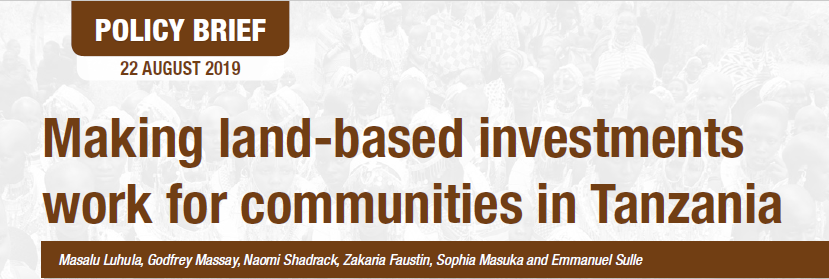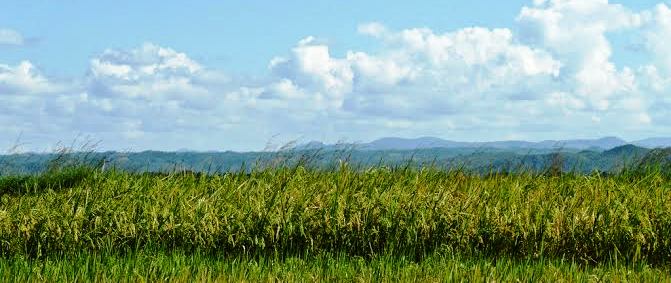Why Land Needs to be a Priority Sector in Tanzania? A Call for an Annual Sector Review
By Godfrey Eliseus Massay, g.massay@tnrf.org, TNRF
March, 2016
Introduction
In the last decade, much has happened in the Tanzania land sector. We have seen the development of major initiatives that provide the framework for increasing agricultural investment including in 2009 Kilimo Kwanza, in 2010 the Southern Agricultural Growth Corridor (SAGCOT), in 2012 the G8 New Alliance supported by USAID, and in 2013 the Big Results Now (BRN). In addition, policy and legislation on land use planning, titling, mortgage financing, urban planning, mining, wildlife management, and livestock, to mention but a few, were passed within this period. At the same time the body held responsible forthe implementation of these, saw shifted leadership and restructuring. For example the Ministry of Lands Housing and Human Settlements Development (MLHHSD) went through the hands of three ministers who saw the government’s flagship land formalization program-MKURABITA, revamped the Strategic Program for Implementation of Land Laws (SPILL 2013) and the establishment of a vibrant information system. In collaboration with the government, donors such as DFID, DANIDA and SIDA to mention a few, have made commitments to support land programs in the SAGCOT regions. Due to emerging land and investment issues, there is growing interest on the best way to establish strong partnerships to address land issues between civil society organisations and government on one hand and private sector on the other. For instance, under the Legend Challenge Fund which is a DFID-supported initiative, non-profit organisations are encouraged to join forces with profit organisations (investors) to access funds and implement projects.
At the international and regional level, land has been at the center of policy debates. There have been commendable efforts taken by the International community and the African Union (AU) to address land rights and tenure security issues resulting from threats posed by large-scale land investments. In 2012, the global Committee on Food Security (CFS) under the Food and Agriculture Organization of the United Nations (FAO) adopted the“Voluntary Guidelines for the Responsible Governance of Tenure of Land, Fisheries, and Forests in the Context of National Food Security”. In 2014, the AU launched the “Guiding Principles on Large Scale Land Based Investments in Africa” which complement the AU Framework and Guidelines on Land Policy in Africa.Efforts are in place to promote these voluntary guidelines to be binding laws at the national level.
Based on the efforts underway in terms of policy, institutional, programmatic, and financial commitments, the land sector should be stronger. However, the evidence on the ground shows that the sector is marred with many challenges. For example; small budget allocations, increase land use conflicts, weak land governance institutions, conflicting land and natural resource mandates, lack of coordination and corruption, to mention a few.
This brief argues for land sector to be a priority sector and for a multi-stakeholder systematic review of the land sector to be carried out annually. The brief draws from official public documents of the MLHHS including budget speeches from the last seven years. It does not capture all mandates of the Ministry of Lands, but highlights some of the areas considered fundamental for initiating discussion and agreement for such an annual sector review to take place. The brief provides relevant information for government officials, donor community, researchers and civil society organisations to advocate and support annual systematic review of the land sector.
Budget Allocations and Expenditures
Overall budget allocation for the MLHHSD has been on the rise for five consecutive years from TShs 33.4 billion in 2009/2010 to 100.8 billion in 2013/2014. However, in the last two fiscal years (2014/2015 and 2015/2016) the budget allocation decreased to TShs 83 billion. While the general budget allocation as approved by the Parliament has been steadily on the rise, the actual allocation has been less than half of that approved from 2012/2013 to 2014/2015. Similarly, the approved budget for development projects has been on the rise since 2009/2010 until 2013/2014. However, the actual allocation has drastically dropped in the last two years. In fact the actual budget allocation for development projects has gradually dropped far below that budgeted for, and had hit zero allocation in 2014/2015. The year 2012/2013 and 2013/2014 are worth mentioning because the budget allocation was higher than other years because the Ministry changed fees, rents and other charges which were expected to raise its revenue. Unfortunately and unexpected to the Ministry, such a change proved to be an impediment to revenue collection. Thus, the Ministry had to make a decision to revisit and revise (reduce) all fees, rents and chargesin 2014/2015 and 2015/2016.To my knowledge, it is not clear why the Minister for lands had not includedactual budgets for salaries, other charges and development projects within that period.
The Ministry cannot make significant changes on the ground if its development projects budgets are small. In the last four years, we have noted that the development budget is often partly funded by development partners.We have also noted that the support from development partners in development budget has been increasing from 10 billion TShs in 2013/2014 to 20.85 billion TShs in 2015/2016. This dependency on development partners is not a good sign because such supports are often affected by international politics and global economic dynamics. The Ministry should get its entire approved budget in time in order to discharge its mandates properly.
|
Financial Year |
Overall Budget |
Salaries |
Other Charges |
Development Projects |
||||
|
Budget |
Actual |
Budget |
Actual |
Budget |
Actual |
Budget |
Actual |
|
|
2009/2010 |
33.4 |
26.2 |
5.9 |
5.9 |
15.5 |
11.9 |
12.0 |
8.3 |
|
2010/2011 |
53.3 |
31.7 |
7.5 |
7.5 |
25.1 |
18.3 |
20.6 |
5.8 |
|
2011/2012 |
50.8 |
34.6 |
9.3 |
8.9 |
19.6 |
19.4 |
21.9 |
6.0 |
|
2012/2013 |
100.7 |
34.4 |
10.4 |
? |
20.3 |
? |
71.0 |
? |
|
2013/2014 |
100.8 |
47.9 |
10.2 |
? |
25.9 |
? |
72.1 |
? |
|
2014/2015 |
85.7 |
32.2 |
11.5 |
10.3 |
40.0 |
21.8 |
34.1 |
0 |
|
2015/2016 |
83.0 |
- |
14.2 |
- |
55.3 |
- |
13.4 |
- |
|
|
NB: All figures are in billion TShs. |
|||||||
Source: MLHHSD Budget Speeches 2009/2010-2015/2016
Revenue Collection
Revenue collection in the country has been on the increase since 2009/2010, but when compared to the revenue collection target of the government, the percentage has varied. For instance, the revenue collected in 2009/2010 was 11.6 billion TShs, which is 75% of the target; the revenue collected in 2014/2015 was 47.0 billion TShs equal to 76.6% of the target. The good news is that the current trend of revenue collection shows that the Ministry will be able to provide for its own budget. In 2014/2005 the actual budget provided to the Ministry (32.2 billion) is less than the revenue collected by the Ministry (47.0 billion), and one may wonder, why didn’t the Ministry spend its revenue collection in supporting its budget demands? This is notwithstanding the fact that, in the same period, there was no allocation made in development projects. The annual sector review will be an appropriate forum to discuss how best the Ministry can increase its revenue collection.
|
Financial Year |
Target (in Bil. TShs) |
Amount collected (in Bil.TShs) |
Percentage |
|
2009/2010 |
15.5 |
11.6 |
75% |
|
2010/2011 |
20.6 |
15.6 |
76% |
|
2011/2012 |
23.6 |
17.1 |
72.5% |
|
2012/2013 |
99.8 |
19.1 |
19.1% |
|
2013/2014 |
100 |
37.03 |
37% |
|
2014/2015 |
61.32 |
47.0 |
76.6% |
|
2015/2016 |
70 |
|
|
Source, MLHHSD Budget Speeches 2009/2010-2015/2016
Cases at theDistrict Land and Housing Tribunals
By April 2015, 49 District Land and Housing Tribunals had been established countrywide – 47 of which are functioning. The data shows that new cases instituted in these tribunals have been increasing to the tune of 13,338 as of April 2015. This is an average of 11,542 new cases instituted every year in these tribunals. From 2009/2010 until 2012/2013 the trend showed that the number of pending cases has increased with an average of 2000 cases every year. The trend has changed in the last two years showing a gradual decrease. However, the fact is as of April, 2015, 18,033 cases are pending in District Land and Housing Tribunals. Close to two thirds of all these cases are concentrated on in ten of the 49 existing tribunals. Mwanza, Temeke, Kinondoni, Ilala, Morogoro and Bukoba tribunals are the most overburdened tribunals with a backlog of cases. In the current regime political language, these tribunals are “boils that need to be opened”.
|
Financial Year |
Instituted Cases |
Determined Cases |
Pending Cases |
|
2009/2010 |
9,219 |
7,756 |
13,203 |
|
2010/2011 |
12,643 |
10,092 |
15,754 |
|
2011/2012 |
10,428 |
8,528 |
17,654 |
|
2012/2013 |
12,074 |
9,831 |
19,897 |
|
2013/2014 |
11,548 |
11,432 |
18,444 |
|
2014/2015 |
13,338 |
13,749 |
18,033 |
Source: MLHHSD Budget Speeches 2009/2010-2015/2016.
Village Land Survey, Registration and Titling
There is no up to date and reliable data on the number of villages in Tanzania. New villages have been created every year, especially, before local government and general election years. The available data shows that, as of April 2015, 11,961 villages have been surveyed. The data shows that averages of 150 villages are surveyed by the Ministry every year in the past five years. A total of 11,889 villages have received the village land certificates as of April, 2015. And, 258,134 certificates of customary rights of occupancy (CCROs) have been issues to individual villagers. Participatory village land use planning has been conducted on an average of 100 villages every year. The focus, at the moment, is in the SAGCOT region with the view of securing land tenure for villages and identifying potential land to be allocated in the land bank for investment purposes. While it is important to secure land rights of the communities in the region, extra care must be taken to ensure that the investment interests do not override livelihood interests.
Call for Annual Land Sector Review
We have pointed out in the introduction to this brief that there is a lot going on in the Tanzania land sector. An annual sector review is crucial as it will enable all stakeholders to understand what is going on the ground. At the moment, there are already some existing good examples of sector reviews being held, including in the Natural Resource Sector which was possible because of the demand from stakeholders and the pressure from donors. The donor interest to support land tenure programs should be complemented by a rigorous transparency and accountability mechanism through such an annual sector review process. We propose that the annual land sector review focus on planning, priority setting and coordination. We hope that the annual sector review will also create a platform where land sector challenges are openly discussed and lasting solutions proposed and adopted by stakeholders.
| Attachment | Size |
|---|---|
| 303.01 KB |


